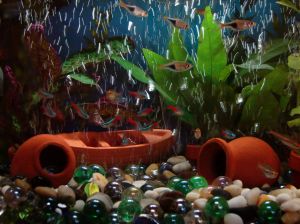Helpful tips to ensure the safe migration of your fresh water aquarium and all of its inhabitants, to their new home.
This article was contributed by Aquarium Advice member BillyZ
There are countless reasons the need may arise, but whatever the reason may be, moving your aquarium is no easy task. This article will provide you with some helpful tips to ensure the safe migration of your fresh water aquarium, and all of its inhabitants, to their new home.
These steps should be followed wether moving your aquarium to another house or within the same house or same room. Before you start be sure that the new location for your aquarium is ready to hold the tank and that power outlets are available. You don’t want to move everything only to find out you don’t have power or that someone else has already claimed that space in the new house for a bookcase. Your aquarium should be the last thing taken out of your old house/apartment and the first thing setup in the new house/apartment. This way you can limit the stress to your fish.
What you will need:
- Bucket or Rubbermaid container to hold fish during the move
- Additional buckets or Rubbermaid containers to hold water from the aquarium, as well as the substrate and plants if you have any. (If your move involves traveling in a vehicle, it is highly recommended that these containers have lids.
- Fresh de-chlorinated water, enough for you to do a large water change.
- Towels
A note on water containers and their weight. 1 gallon of water weighs just over 8 pounds (8.34 pounds to be exact). This makes a single 5 gallon bucket 41.7 pounds of weight. If you are moving to a new house you may be best served by placing larger containers for water in the moving vehicle while they are empty and using a manageable size bucket carried from the tank to the vehicle to fill them. When you arrive at your location do the same thing in reverse to fill the tank. Any container more than 5 gallons will be difficult to carry and could cause injury. You could run tubing to drain the tank directly into the containers in the vehicle, but it has been pointed out to me by glmclell to be sure you do NOT use garden hose to do this as they contain a number of materials to inhibit algal and fungal growth that will contaminate your tank water. He suggests visiting an RV or Boating store and look for FDA approved, drinking water safe hose.
When you’re ready to start moving the first thing you should do is remove the fish from the tank so they won’t be subjected to all the commotion that will soon follow. Get either a 5-gallon bucket or a large Rubbermaid container that will give your fish enough room to move around freely. They should hopefully only be in the container for a couple hours. (Of course, if you have a large tank or many fish, you may need to use more than one container).
Fill this container with water from your aquarium. Place the heater and air bubbler from your aquarium in this container as well. If everything goes well your fish will only be here for an hour or two, but be sure that if something goes wrong, your fish will be able survive in the bucket for up to a day. Place a loose fitting lid on this container to prevent your fish from jumping out.
If you have plants in your tank you can place them in this same bucket (providing some comfort for your fish) or you can place them in a separate bucket, be sure to keep them wet. Any tank decorations should also be removed at this point and can be kept in a heavy plastic bag, or, yet another bucket.
Unplug and disconnect your lights, filters and any other equipment for your aquarium. It is best to keep any filter media at least damp. Most should be fine for an hour or two. If your move may take longer than that, you may wish to keep your filter media in something like a gallon size Ziploc bag with just enough water from the tank to keep it wet.
Take the additional buckets or Rubbermaid containers and begin filling them with water from the tank. I would recommend that at least half of the tank’s water be kept to be returned to the aquarium in its new location. Doing so reduces the chance of restarting a cycle in the aquarium as well as reduces the risk of shocking your fish when they are returned to the aquarium. Be sure you have enough fresh water to make up for any water from the aquarium you’re not taking with you.
Begin removing the substrate and placing it in one of the containers. If your tank has been established for a long time, the bottom layers of the substrate may be very dirty. If this is the case, use some of the de-chlorinated water to rinse the substrate before returning it to the aquarium after the move. Don’t use pure tap water (if you have city/municipal water), as the chlorine can kill the bacteria on the substrate that is important to the health of your tank.
Take this opportunity to rinse out your tank of any left over detritus or dirt left over from removing everything else from the tank. Aquariums should NEVER be moved with any amount of water or substrate in them as they will be quite heavy and you can risk injury to yourself or damage to the aquarium from the shifting weight. Always move your aquarium when its empty of water and substrate.
Move the tank and all your buckets to the tank’s new location. Set up the stand and tank and be sure it is level and you have enough room for all your equipment behind and around the tank and stand. Begin replacing the substrate in the tank. Replace any rocks or decorations as well.
Begin returning the saved water to the tank. Check for leaks!!! Picking up and moving tanks, especially old tanks, can separate their seams just enough to cause a leak.
Replace any plants and move the heater and air bubbler from the bucket with your fish to the tank.
Top off the tank with your fresh water you already had made up.
Check your tank water to be sure there was not a lot of ammonia released in stirring up the substrate. If your water tests high in ammonia, do a water change as necessary to bring down the ammonia levels.
Once your water has been tested for ammonia, begin acclimating your fish to the tank’s water. There should hopefully be little difference in the water quality, but the goal is to make it as stress free of a change for the fish as possible.
Hook up your lights, filters and any other remaining equipment. Once your fish have been acclimated, return them to the tank.
Check all your water quality levels the next day to be sure a new cycle has not started and that your fish and plants are not in danger.

